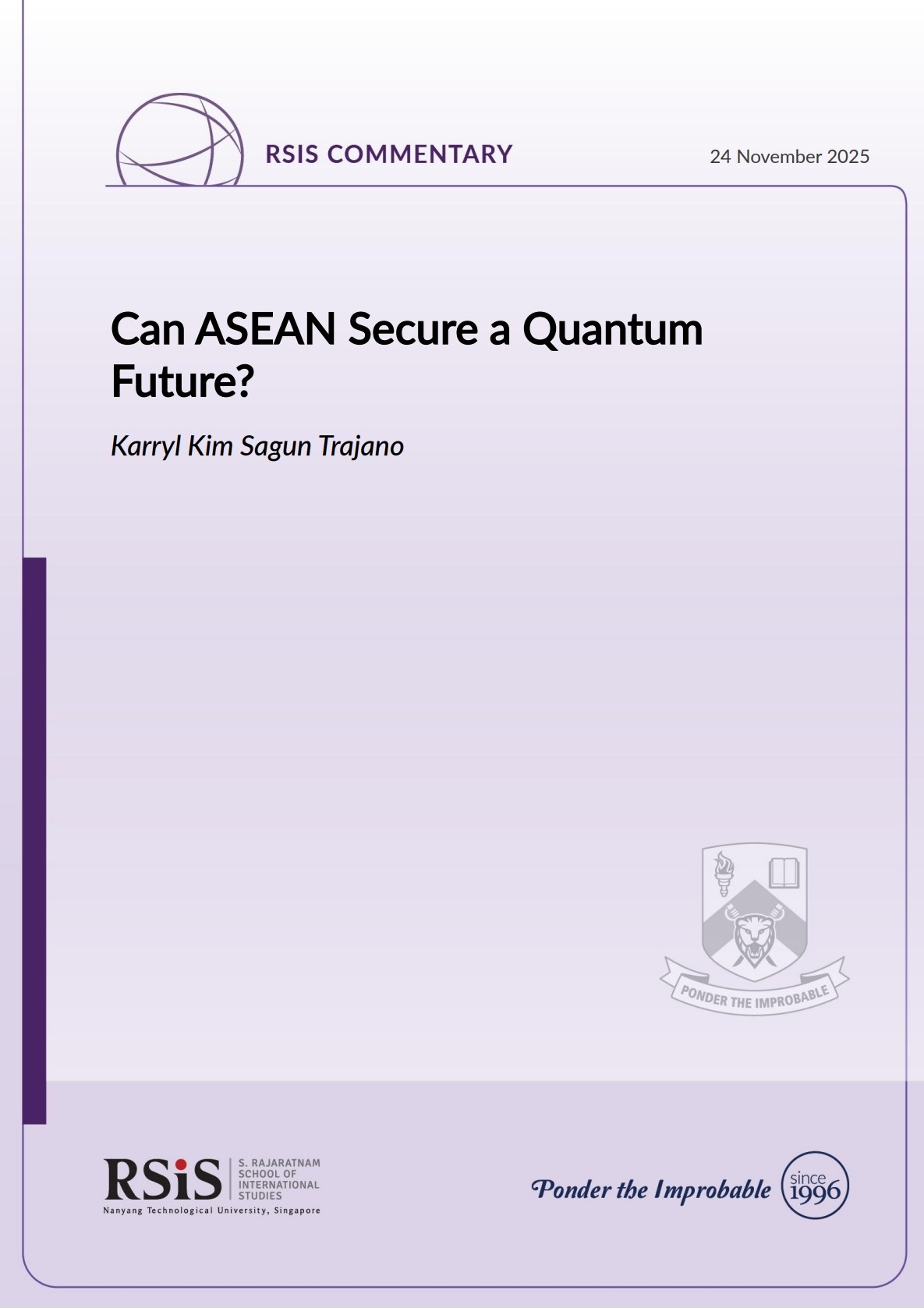24 November 2025
- RSIS
- Publication
- RSIS Publications
- Can ASEAN Secure a Quantum Future?
SYNOPSIS
To harness the power of quantum, Southeast Asia must upskill, innovate, and think beyond the vendor-supplier model.

COMMENTARY
Quantinuum, the world’s largest quantum company, is planting its flag in Singapore through a new collaboration with the country’s National Quantum Office. This, together with a robust National Quantum Strategy (2024), signals the city-state’s growing weight in the global quantum race. However, while Singapore gets ready for further participation in the quantum economy, the rest of the region risks falling behind.
As quantum technologies are no longer a far-off scientific dream, they are fast becoming a strategic reality poised to reshape the global order. In 2025’s International Year of Quantum Science and Technology, Southeast Asia faces an important question: Can it secure its own quantum future, or will it be shaped by forces beyond its control?
What if Southeast Asia Falls Behind?
For a region juggling economic growth, technological sovereignty, and geopolitical pressure, falling behind in the quantum race is a serious risk. Unlike AI, which excels at processing huge volumes of data, quantum computing tackles deep, complex problems in simulation, optimisation, and secure communication. It is the backbone of what scientists call “Quantum 2.0”, the next leap after Quantum 1.0 which brought us semiconductors, lasers, transistors, MRI, and atomic clocks. Governments will increasingly need experts to identify critical problems and apply quantum computing, with AI and quantum likely converging to complement each other.
But the promise of quantum arrives in a fractured geopolitical landscape. In contrast with the space race, which evolved from competition to cooperation through shared projects, the quantum race is moving in the opposite direction: closed, proprietary, and increasingly politicised. Export controls on even low-performance quantum devices by the United States and other major powers, restrictions on research collaboration, and the nationalisation of technological standards are constraining global knowledge flows and raising the cost of innovation.
For Southeast Asia, this fragmentation narrows the path forward. Most ASEAN member states still lack the local expertise, infrastructure, and research capabilities needed to develop their own quantum technologies. Malaysian policymakers, for instance, are beginning to recognise quantum’s strategic dimensions. Yet the country’s approach remains largely vendor-supplier based with it acquiring access to quantum computing infrastructure through partnerships rather than domestic capability building. This model can enable participation but also risks long-term dependency and shallow capability-building if not paired with domestic capacity-building and broader investment.
The region also urgently needs to adopt new encryption protocols, including post-quantum cryptography and quantum key distribution, to safeguard trust in its critical systems such as banking. Lagging in this domain could erode confidence, deter investment, and threaten regional economic stability. More broadly, falling behind in quantum technologies could impose a significant economic loss, one that Southeast Asian nations cannot afford, given that the global quantum industry is projected to reach around US$97 billion by 2035.
The quantum supply chain is likewise intricate and specialised, reliant on rare-earth materials, with geopolitical rivalries already disrupting access. Technological fragmentation, where incompatible systems proliferate, could undermine interoperability and deepen inequalities, leaving smaller countries and newer players, including ASEAN states, vulnerable to alignment pressures from major powers.
This dynamic is particularly relevant to Southeast Asia, whose economies depend on open trade and diversified partnerships. A fragmented quantum ecosystem could expose the region to coercive dependencies. While ASEAN could, in theory, serve as a neutral convening space for quantum research, governance, and standards, this remains aspirational without a dedicated regional policy framework, technical expertise, and alignment among member states. The gap is significant, as the ASEAN Digital Masterplan 2025 notably makes no mention of quantum across its 140 pages.
This is not to suggest that quantum ambitions are absent in the region. Singapore has built Southeast Asia’s first quantum-safe network infrastructure, Thailand has introduced a national quantum roadmap, while Indonesia has established a research centre for quantum physics, among other national-level initiatives. At the regional level, efforts such as the ad hoc ASEAN Quantum Committee and the SEA Quantum Network reflect growing recognition of quantum’s importance.
Way Forward
But, while momentum is slowly building, Southeast Asia must address three interlinked priorities to secure a meaningful quantum future.
First, it must formalise regional coordination. ASEAN must move beyond ad hoc working groups and establish a dedicated mechanism to harmonise standards, technical definitions, and security protocols. A coordinated approach can preserve strategic autonomy while avoiding fragmented national efforts.
Second, broaden capacity-building. Quantum cannot remain confined to elite institutions and single counties. It requires region-wide investment in education, local talent pipelines, and industry partnerships that build hands-on capability, and not just procurement.
Third, integrate quantum into strategic planning. Quantum (among other emerging technologies) should be reflected in the next iteration of its Digital Masterplan. Early applications such as quantum machine learning for disaster early warning, for instance, can offer immediate benefits for a region highly exposed to natural hazards, while laying the foundation for more advanced uses in agriculture, genomics, and data security.
Conclusion
Quantum will not transform Southeast Asia overnight. But its cumulative impact on security, economic competitiveness, and technological sovereignty will certainly refine if not redefine the region’s strategic future. Treating quantum as a distant science experiment, rather than a here-and-now priority, risks leaving the region dependent on external powers. A coordinated, forward-looking approach can instead position ASEAN as an active shaper of its own quantum landscape.
As quantum technologies prompt new forms of cooperation, ASEAN’s long tradition of consensus-building can be a strategic asset. The real question is whether the region can move quickly, and collectively, to secure its place in the quantum future.
About the Author
A version of this article first appeared in The Interpreter, published by the Lowy Institute.
Karryl Kim Sagun Trajano is a Research Fellow at Future Issues and Technology (FIT), S. Rajaratnam School of International Studies (RSIS), Nanyang Technological University (NTU), Singapore.
SYNOPSIS
To harness the power of quantum, Southeast Asia must upskill, innovate, and think beyond the vendor-supplier model.

COMMENTARY
Quantinuum, the world’s largest quantum company, is planting its flag in Singapore through a new collaboration with the country’s National Quantum Office. This, together with a robust National Quantum Strategy (2024), signals the city-state’s growing weight in the global quantum race. However, while Singapore gets ready for further participation in the quantum economy, the rest of the region risks falling behind.
As quantum technologies are no longer a far-off scientific dream, they are fast becoming a strategic reality poised to reshape the global order. In 2025’s International Year of Quantum Science and Technology, Southeast Asia faces an important question: Can it secure its own quantum future, or will it be shaped by forces beyond its control?
What if Southeast Asia Falls Behind?
For a region juggling economic growth, technological sovereignty, and geopolitical pressure, falling behind in the quantum race is a serious risk. Unlike AI, which excels at processing huge volumes of data, quantum computing tackles deep, complex problems in simulation, optimisation, and secure communication. It is the backbone of what scientists call “Quantum 2.0”, the next leap after Quantum 1.0 which brought us semiconductors, lasers, transistors, MRI, and atomic clocks. Governments will increasingly need experts to identify critical problems and apply quantum computing, with AI and quantum likely converging to complement each other.
But the promise of quantum arrives in a fractured geopolitical landscape. In contrast with the space race, which evolved from competition to cooperation through shared projects, the quantum race is moving in the opposite direction: closed, proprietary, and increasingly politicised. Export controls on even low-performance quantum devices by the United States and other major powers, restrictions on research collaboration, and the nationalisation of technological standards are constraining global knowledge flows and raising the cost of innovation.
For Southeast Asia, this fragmentation narrows the path forward. Most ASEAN member states still lack the local expertise, infrastructure, and research capabilities needed to develop their own quantum technologies. Malaysian policymakers, for instance, are beginning to recognise quantum’s strategic dimensions. Yet the country’s approach remains largely vendor-supplier based with it acquiring access to quantum computing infrastructure through partnerships rather than domestic capability building. This model can enable participation but also risks long-term dependency and shallow capability-building if not paired with domestic capacity-building and broader investment.
The region also urgently needs to adopt new encryption protocols, including post-quantum cryptography and quantum key distribution, to safeguard trust in its critical systems such as banking. Lagging in this domain could erode confidence, deter investment, and threaten regional economic stability. More broadly, falling behind in quantum technologies could impose a significant economic loss, one that Southeast Asian nations cannot afford, given that the global quantum industry is projected to reach around US$97 billion by 2035.
The quantum supply chain is likewise intricate and specialised, reliant on rare-earth materials, with geopolitical rivalries already disrupting access. Technological fragmentation, where incompatible systems proliferate, could undermine interoperability and deepen inequalities, leaving smaller countries and newer players, including ASEAN states, vulnerable to alignment pressures from major powers.
This dynamic is particularly relevant to Southeast Asia, whose economies depend on open trade and diversified partnerships. A fragmented quantum ecosystem could expose the region to coercive dependencies. While ASEAN could, in theory, serve as a neutral convening space for quantum research, governance, and standards, this remains aspirational without a dedicated regional policy framework, technical expertise, and alignment among member states. The gap is significant, as the ASEAN Digital Masterplan 2025 notably makes no mention of quantum across its 140 pages.
This is not to suggest that quantum ambitions are absent in the region. Singapore has built Southeast Asia’s first quantum-safe network infrastructure, Thailand has introduced a national quantum roadmap, while Indonesia has established a research centre for quantum physics, among other national-level initiatives. At the regional level, efforts such as the ad hoc ASEAN Quantum Committee and the SEA Quantum Network reflect growing recognition of quantum’s importance.
Way Forward
But, while momentum is slowly building, Southeast Asia must address three interlinked priorities to secure a meaningful quantum future.
First, it must formalise regional coordination. ASEAN must move beyond ad hoc working groups and establish a dedicated mechanism to harmonise standards, technical definitions, and security protocols. A coordinated approach can preserve strategic autonomy while avoiding fragmented national efforts.
Second, broaden capacity-building. Quantum cannot remain confined to elite institutions and single counties. It requires region-wide investment in education, local talent pipelines, and industry partnerships that build hands-on capability, and not just procurement.
Third, integrate quantum into strategic planning. Quantum (among other emerging technologies) should be reflected in the next iteration of its Digital Masterplan. Early applications such as quantum machine learning for disaster early warning, for instance, can offer immediate benefits for a region highly exposed to natural hazards, while laying the foundation for more advanced uses in agriculture, genomics, and data security.
Conclusion
Quantum will not transform Southeast Asia overnight. But its cumulative impact on security, economic competitiveness, and technological sovereignty will certainly refine if not redefine the region’s strategic future. Treating quantum as a distant science experiment, rather than a here-and-now priority, risks leaving the region dependent on external powers. A coordinated, forward-looking approach can instead position ASEAN as an active shaper of its own quantum landscape.
As quantum technologies prompt new forms of cooperation, ASEAN’s long tradition of consensus-building can be a strategic asset. The real question is whether the region can move quickly, and collectively, to secure its place in the quantum future.
About the Author
A version of this article first appeared in The Interpreter, published by the Lowy Institute.
Karryl Kim Sagun Trajano is a Research Fellow at Future Issues and Technology (FIT), S. Rajaratnam School of International Studies (RSIS), Nanyang Technological University (NTU), Singapore.





